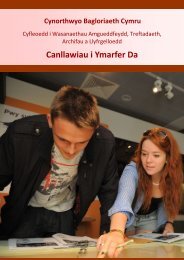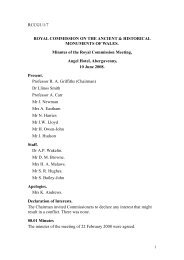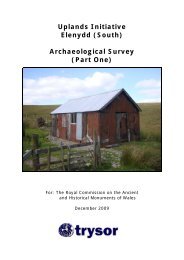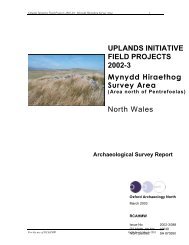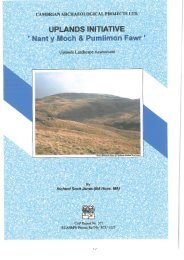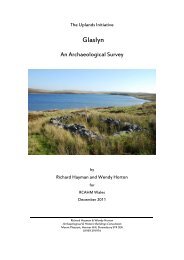Banc y Celyn, Brecknockshire - Royal Commission on the Ancient ...
Banc y Celyn, Brecknockshire - Royal Commission on the Ancient ...
Banc y Celyn, Brecknockshire - Royal Commission on the Ancient ...
- No tags were found...
Create successful ePaper yourself
Turn your PDF publications into a flip-book with our unique Google optimized e-Paper software.
Uplands Initiative – <str<strong>on</strong>g>Banc</str<strong>on</strong>g> y <str<strong>on</strong>g>Celyn</str<strong>on</strong>g> 2008suggested that <strong>the</strong>re were more st<strong>on</strong>es hidden from view beneath <strong>the</strong> surface, but as <strong>the</strong> siteis now a SAM, this exercise cannot be repeated.At <strong>the</strong> sou<strong>the</strong>astern side of <strong>the</strong> postulated circle lies a low mound of earth, with at leastthree st<strong>on</strong>es protruding through <strong>the</strong> grass or laying flat. The RCAHMWs<str<strong>on</strong>g>Brecknockshire</str<strong>on</strong>g> Inventory (RCAHMW, 1997, 158) interprets this mound as a “portal”into <strong>the</strong> st<strong>on</strong>e circle. However, <strong>the</strong>re is nothing to suggest that this mound is in any wayassociated with <strong>the</strong> two upright st<strong>on</strong>es to <strong>the</strong> northwest, as it appears to form a discretefeature and may ei<strong>the</strong>r be a naturally occurring mound or is even reminiscent of a smallcairn or barrow.The field evidence is at best inc<strong>on</strong>clusive as to whe<strong>the</strong>r this site is a Br<strong>on</strong>ze Age st<strong>on</strong>ecircle. On <strong>the</strong> basis of surface evidence, it seems difficult to accept <strong>the</strong> identificati<strong>on</strong> of<strong>the</strong> features here as being anything o<strong>the</strong>r than naturally occurring. Fur<strong>the</strong>rarchaeological investigati<strong>on</strong> is required to c<strong>on</strong>firm its designati<strong>on</strong> as a st<strong>on</strong>e circle.Cairns and BarrowsThe most significant field evidence for prehistoric activity in <strong>the</strong> <str<strong>on</strong>g>Banc</str<strong>on</strong>g> y <str<strong>on</strong>g>Celyn</str<strong>on</strong>g> studyarea are 17 Br<strong>on</strong>ze Age funerary cairns and 3 possible funerary cairns, which have beenidentified.Prior to <strong>the</strong> field survey, <strong>on</strong>ly 7 Br<strong>on</strong>ze Age funerary cairns or sites were recorded in <strong>the</strong>NMR for <strong>the</strong> area. These included six cairns;• Twyn y Bîg, Cairn – NPRN 305763• Blaen Llwyn Ddu Cairn - NPRN 305778• Gwaun Ymrys<strong>on</strong> Cairn I - NPRN 305782• Cefn Clawdd Cairn I - NPRN 305781• Cefn Clawdd Cairn II - NPRN 305784• Gwaun Ymrys<strong>on</strong> Cairn II - NPRN 305783Of <strong>the</strong>se six cairns, <strong>the</strong> most impressive is undoubtedly <strong>the</strong> Cefn Clawdd Cairn II,which is curiously <strong>on</strong>e of <strong>on</strong>ly two <strong>on</strong> <strong>the</strong> list which are not Scheduled <strong>Ancient</strong>M<strong>on</strong>uments (Blaen Llwyn Ddu being <strong>the</strong> sec<strong>on</strong>d). It is a relatively well-preservedcairn, <strong>the</strong> largest found within <strong>the</strong> study area. It survives as a prominent mound, visible<strong>on</strong> <strong>the</strong> skyline when viewed from lower ground to <strong>the</strong> north and east. It measures 18min diameter and up to 1.2m high. The cairn has a hollow at its centre that gives <strong>the</strong>m<strong>on</strong>ument a ring like appearance. Whe<strong>the</strong>r this is an original characteristic, whichwould suggest that <strong>the</strong> cairn is in fact a ring cairn, or <strong>the</strong> result of antiquarian excavati<strong>on</strong>or st<strong>on</strong>e robbing which has disturbed <strong>the</strong> interior of <strong>the</strong> mound, is unclear. 19 th centuryOrdnance Survey surveyors saw <strong>the</strong> m<strong>on</strong>ument as being a ring-like feature and <strong>the</strong> 1831Ordnance Survey map depicts it as a ring. The 1st editi<strong>on</strong> 1:2500 map of 1888 shows itas an “Old Sheepfold”, indicating that its ring-like bank was interpreted as <strong>the</strong> wall of aruined sheepfold.The <strong>on</strong>ly o<strong>the</strong>r feature of note is a st<strong>on</strong>y mound at <strong>the</strong> western side of <strong>the</strong> cairn, whichhas been interpreted as possibly being a spoil heap cast up when <strong>the</strong> centre of <strong>the</strong> cairnwas dug out at some time in <strong>the</strong> past. However, it is not impossible that this mound is an32




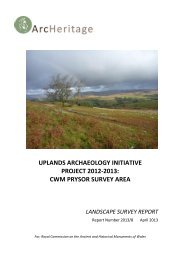
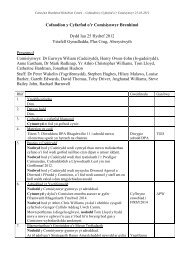
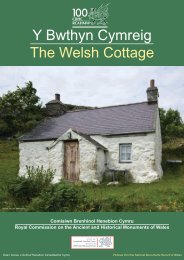
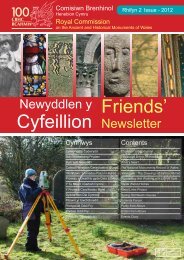
![The Source of the Usk Walk [2012 PDF]](https://img.yumpu.com/49285699/1/190x245/the-source-of-the-usk-walk-2012-pdf.jpg?quality=85)

